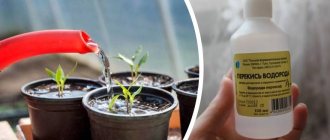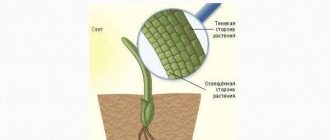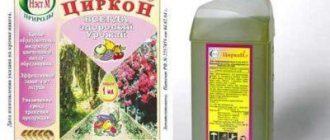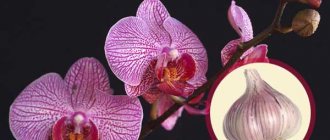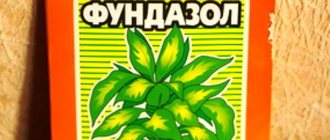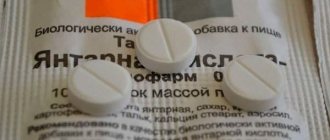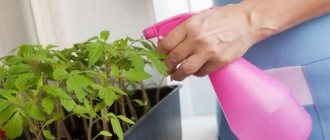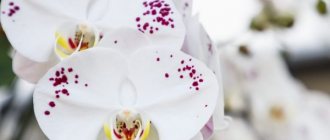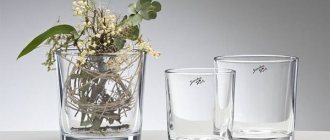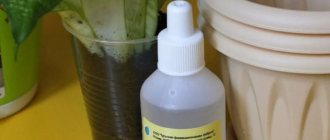Orchids are perennial ornamental indoor plants that need good care. Many gardeners rightly believe that hydrogen peroxide is one of the best fertilizers for orchids, because it has a great influence on the development and growth of this decorative culture.
Hydrogen peroxide and orchids. The illustration for the article is used from open sources.
What is it, can an orchid be treated with it?
Peroxide is a chemical compound H2O2. It has an asymmetrical structure, undefined oxygen electron pairs. Often used in medicine for treating wounds or disinfecting. It is a popular remedy among housewives; folk remedies are prepared from it for cleaning textiles or hard surfaces.
Flower growers have found in this chemical compound an effective remedy that affects the growth of orchids. Penetrating into living cells, it activates biochemical reactions leading to differentiation and cell growth. Hydrogen peroxide will benefit the flower only with moderate and adequate use.
Attention! H2O2 cannot be treated with an orchid after feeding and watering with copper or iron based products. When interacting with these chemical compounds, a dangerous radical is formed, which will cause the death of biological plant cells.
What are the results of improper watering?
Improper watering can lead to the death of the orchid. Although this plant is moisture-loving, it is still better to underwater than overwater. Otherwise, the roots will simply rot. After all, in nature, orchids grow on stones and tree branches.
Do not allow water to stagnate in the tray and in the orchid pot. This will lead to rotting of the roots and death of the plant. When there is an excess of moisture, swelling appears on the leaves , which cannot be treated; they only need to be removed.
We must not forget that an orchid is a capricious plant, and proper watering is one of the important conditions for its health. If you follow simple rules, the orchid will delight you with its flowering for a long time.
Benefit or harm
Experiments have been carried out for a long time, and there have been many disputes regarding whether hydrogen peroxide is harmful or beneficial for orchids. Some of its advantages include the following:
- soil disinfection;
- cleansing the plant from all types of pests: insects, microorganisms, microbes, mites;
- strengthening the immune system, acquiring a protective reaction to various diseases;
- improvement of flower growth.
There is no harm in using hydrogen peroxide for orchids, since the chemical element is not toxic, and all active substances quickly disintegrate when used. But it will be harmless only with moderate use.
If you frequently feed a plant with hydrogen peroxide, the plant will become overly sterilized, which is why its immune system will no longer develop resistance to the penetration of harmful bacteria and microorganisms.
Purposes of application
Based on useful words, the purposes of using peroxide for orchids are as follows:
- Preventing the entry or elimination of infections or bacteria. The active substances affect every cell of the plant, destroying the fungus or bacteria present on it.
- Oxygen saturation. The chemical element reduces the load on the flower, improves the respiration of the root system and leaves.
Flower growers use a chemical compound of hydrogen to rid the plant of pests, but they are not always able to achieve a positive effect after treatment. It is recommended to choose another method to combat insects, since eliminating them requires a large dosage of this substance, which can be fatal to the orchid.
Effects of hydrogen peroxide
Watering decorative orchids with hydrogen peroxide is useful because:
- kills pests and heals the plant;
- fertilizes the substrate;
- accelerates flower growth;
- acts as a fungicide;
- saturates the soil with oxygen
- strengthens small roots
For houseplants, peroxide is used as a means of combating diseases or pests.
At first, water and spray the plant with caution. When processing phalaenopsis, other fertilizers are not used to avoid an undesirable reaction.
Watering decorative orchids with hydrogen peroxide is beneficial
Concentration, dilution rules
Highly concentrated peroxide containing 30% active substance must first be diluted with water. The purpose of its use is the disinfection of swimming pools or technical devices. The concentration should be 1 tablespoon of peroxide per 1 liter of water. But it is still not recommended to treat the plant with such a technical means; you should choose a more gentle concentrate.
Important!
Pharmacy hydrogen peroxide has a concentration of 3%. You can water your orchid with it without prior dilution. If a chemical compound is diluted with water, it will completely dissolve in it and be ineffective.
Acceptable processing methods
Many inexperienced flower growers who do not know all the features of the effect of hydrogen peroxide on plant crops use this compound in the form of a solution for watering, fertilizing or spraying orchids. Treat the soil with an aqueous solution containing peroxide or soak the pots before planting the flower to disinfect everything.
Experienced flower growers and gardeners assure that all these methods are ineffective for the plant. In their opinion, the chemical element should be used for the following processing methods:
- rubbing the green leaves of a flower to eliminate infection or bacteria;
- soaking seeds before planting to disinfect them from harmful substances;
- spot treatment of damaged areas using a cotton swab.
But, all these methods of treatment must be carried out only with a pharmaceutical chemical element, the concentration of which is 3%, a highly concentrated technical composition will be destructive for the plant crop, it is better not to use it.
Attention!
Before carrying out the treatment, you must first thoroughly wash your hands with soap, wipe dry, and treat with a disinfectant. Instead, you can put disposable medical gloves on your hands. Bacteria accumulate on the fingers and palms, which can infect the leaves or flowers of the orchid.
Hydrogen peroxide for diseases
In case of damage by pests and bacterial infections, prepare a standard solution: 250 ml of water per 30 ml of product, add 40 drops of iodine to it. By treating with such a solution, the gardener protects the orchid from spider mites, scale insects, small midges and mealyworms. Watering and spraying should be done several times.
If the pest infestation is extensive, medical alcohol is added to the solution before spraying. A week later, watering and spraying are repeated to consolidate the result.
If a flower is damaged by fungal diseases: mold, root rot, add alcohol and 2 tbsp to the standard solution. soap shavings. This solution disinfects the affected areas and has an aeration effect on the substrate.
Processing technique
The composition and method of application depend directly on the purpose for which you want to treat the orchid with hydrogen peroxide. Basic methods include wiping leaves, soaking seeds, spot treatments and spraying.
Wiping leaves
You may be interested in: How to care for orchids in a pot after purchase Why the leaves of an orchid wither and how to save it Features of the care and propagation of the Dendrobium Nobile orchid
Wiping the leaves is carried out in order to improve the health of the plant maples and eliminate bacterial or infectious lesions from them. To process it you need to do the following:
- Take a clean cotton swab or a small piece of cotton wool.
- Soak it in a solution of hydrogen peroxide.
- Gently lubricate each damaged leaf with it strictly around the source of infection.
The treatment should be performed once, then observe the behavior of the plant. If the expected benefit does not appear within 7 days, the procedure should be repeated.
Soaking the seeds
To disinfect plant seeds, you must prepare a solution in advance. To do this, you need to dilute 25 drops of hydrogen peroxide with a concentration of 3% in 250 milliliters of water. Pour the solution into a deep bowl, carefully place the plant seeds into it and leave to soak for 30 minutes.
After half an hour, drain the water from the container and fill it with cold running water to rinse each seed with it. The washed planting material should be placed on a kitchen towel or a sheet of newspaper in a cool and dry place. After it is completely dry, it can be deepened into the soil.
Spot treatment
Spot treatment is carried out with the aim of healing the plant; the impact is carried out on the source of infection or bacteria. To do this, you need to pour it into a container with a spray bottle; a container for a medical or cosmetic product is suitable for this. Hydrogen peroxide needs to be sprayed onto the lesion at a short distance from the leaf. If there is no special container with a sprayer, then a similar action can be performed using a cotton swab.
Spraying
To rid the plant of disease or pests, you can prepare a fertilizer based on hydrogen peroxide. For this purpose the following components will be required:
- hydrogen peroxide – 30 grams;
- water – 0.25 liters;
- iodine – 40 drops.
Iodine and hydrogen peroxide must be dissolved in water and the entire contents must be thoroughly mixed until all active components are completely dissolved. The resulting fertilizer needs to be sprayed or watered on the plant. Next, you need to monitor its condition; if necessary, you need to repeat the processing again. If a lot of pests have accumulated on the flower, then you can add a few drops of medical alcohol to the solution.
There is a version that a plant can be treated with a solution of hydrogen peroxide to stimulate its flowering. In fact, this chemical element does not have such properties, so it is not used to increase the number of flowers and accelerate their appearance.
Attention!
The undiluted solution can only be sprayed, watered the plant or wiped the leaves. But they cannot process sections. It is also worth preventing its contact with flowers and buds, and leaf axils. It is not recommended to use hydrogen peroxide on a plant in sunny weather, as it may cause burns on the leaves.
How to fix errors?
If overwatering does occur, the leaves become wrinkled, and the flowers or buds fall off, the orchid needs to be replanted. Under no circumstances should you dry a flooded orchid near heating devices or other heat sources.
- You need to remove the flower from the pot without damaging the roots, clean the soil from them and soak in water for 15 minutes.
- Then let it dry and examine each root.
- Remove all that are soaked or infected with fungus with pruning shears, and treat the cut areas with charcoal.
- Disinfect the new pot and replant without compacting the soil.
If almost all the roots are dead, then you cannot replant immediately. The orchid should be placed in a plastic jar with water so that its remaining roots almost touch the water. Maintain the water at this level and spray the plant. When the roots reach at least 5 cm, you can replant (how to water the plant after replanting?).
Practice shows that one of the main reasons for the death of orchids is improper watering. Therefore, in order to avoid mistakes, especially for novice flower growers, you must first study how an orchid grows in nature, how it feeds, and, based on this knowledge, try to recreate its natural conditions as much as possible.
Do you want to grow an orchid or already own this wonderful flower? Then it will be useful for you to read our articles on how to properly water this plant during flowering, as well as in the autumn and winter.
Is it possible to overdose
Orchid and hydrogen peroxide are a very successful combination, but only if you use the chemical element in moderation. But this issue is controversial, since peroxide tends to disintegrate in water. Accordingly, it becomes obvious that an overdose of this substance in dissolved form is impossible.
But if the treatment is carried out with undiluted peroxide, then the orchids can be damaged, even to the point of destroying the root system. The same effect will occur when using technical 30% hydrogen peroxide as a top dressing or fertilizer. Another possible harm is a weakening of the immune system, to the point where the plant loses protection against infections and bacteria.
Reviews from flower growers
Irina
I have been growing orchids for more than 5 years, during which time I have repeatedly encountered the fact that this plant is susceptible to various diseases, including insects. For all types of lesions, I treat the leaves with hydrogen peroxide. But, I recommend slightly moistening the cotton wool and making several movements around the affected surface. If you overdo it, the effect will be the opposite.
Marina
Yes, indeed, hydrogen peroxide works well against pests and bacteria. I once used it as a fertilizer, but did not notice a positive effect. Then, an experienced gardener explained to me that for good orchid growth, nitrogen, phosphorus, microelements and macroelements are needed. Of course, none of this is contained in peroxide.
Hydrogen peroxide is one of the best fertilizers for orchids
Orchids are perennial ornamental indoor plants that need good care. Many gardeners rightly believe that hydrogen peroxide is one of the best fertilizers for orchids, because it has a great influence on the development and growth of this decorative culture.
Hydrogen peroxide and orchids. The illustration for the article is used from open sources.
Expert opinion
Experts in the field of floriculture have a controversial opinion about the effects of hydrogen peroxide on orchids. Some of them claim that it is absolutely useless, others say that a positive effect is still observed from it. It was possible to come to the conclusion that it is really useful if it is not diluted with water and used in moderation.
Expert Oksana Nikolaevna
Peroxide will become an essential helper if the flower has not been properly cared for. It will eliminate all infections, pathogenic substances and prevent the occurrence of viral or infectious diseases. But, it is not used to eliminate pests and saturate the plant with nutrients.
Hydrogen peroxide is a non-toxic chemical compound. That is why it can be used to treat even such capricious plants as orchids, but the dosage must be observed.
What kind of water should I use?
To water orchids, use soft, settled tap water, as well as boiled, rain, distilled water, and melted snow.
Rainwater and melted snow collected in the city will not benefit plants because they contain large amounts of gases and dust. Country snow and rainwater are stored in a cold place.
If there is no such water, you can boil tap water to make it softer and remove bacteria. The water filtration method is also suitable. Oxalic acid helps make water softer. You can remove high acidity with a few drops of lemon juice.
Distilled water is considered dead, it does not contain salts, so it is diluted with tap water: if the water is very hard, then take 2 parts distilled for one part of tap water, with medium hardness - one to one.
It is recommended to enrich any water with oxygen by pouring it from one container to another before watering.

